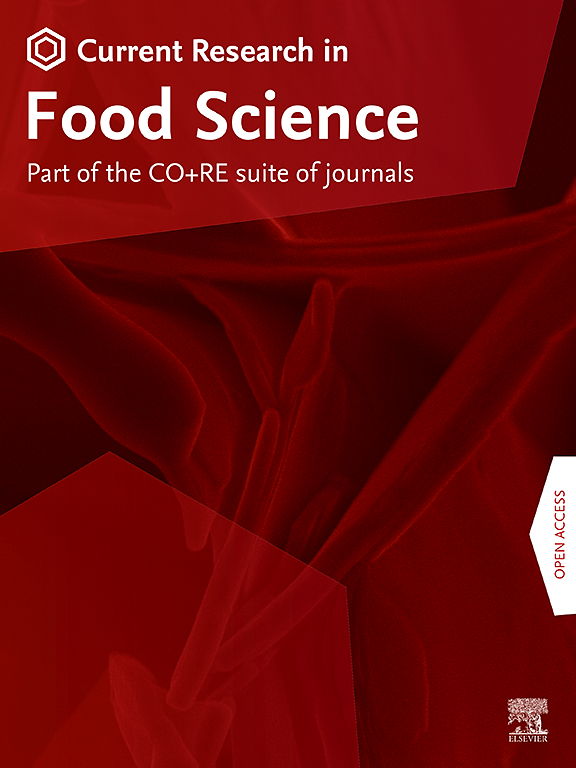Trichosanthes kirilowii Maxim. Polysaccharide attenuates diabetes through the synergistic impact of lipid metabolism and modulating gut microbiota
IF 6.2
2区 农林科学
Q1 FOOD SCIENCE & TECHNOLOGY
引用次数: 0
Abstract
Polysaccharide, a chain of sugars bound by glycosidic bonds, have a wide range of physiological activities, including hypoglycemic activity. In present study, we established T2DM mice models to explore the effects and mechanism of Trichosanthes kirilowii Maxim polysaccharide (TMSP1) on high-fat diet/streptozotocin (HF-STZ) induced diabetes mice. The results showed that high-fat diet significantly increased the oral glucose tolerance test (OGTT), viscera index, oxidative stress, impaired glucose tolerance, decreased body weight, immune response and short-chain fatty acid (SCFAs) content, and disrupted the balance of intestinal flora structure. However, after 6 weeks of TMSP1 intervention decreased lipid accumulation, ameliorated gut microbiota dysbiosis by increasing SCFAs-producing bacteria and mitigated intestinal inflammation and oxidative stress. Moreover, TMSP1 significantly restored the integrity of the intestinal epithelial barrier and mucus barrier. The results of fecal microbiota transplantation confirmed that TMSP1 exerted hypoglycemic effect through regulating intestinal flora to a certain extent. Collectively, the findings revealed TMSP1 intervention inhibits hyperglycemia by improving gut microbiota disorder, lipid metabolism, and inflammation. Hence, TMSP1 may be an effective measure to ameliorate HF-STZ induced diabetes.

Trichosanthes kirilowii Maxim。多糖通过脂质代谢和调节肠道微生物群的协同作用减轻糖尿病
多糖是一种由糖苷键结合的糖链,具有广泛的生理活性,包括降血糖活性。本研究通过建立T2DM小鼠模型,探讨栝楼多糖(TMSP1)对高脂饮食/链脲佐菌素(HF-STZ)诱导的糖尿病小鼠的作用及机制。结果表明,高脂肪日粮显著增加了小鼠口服糖耐量试验(OGTT)、内脏指数、氧化应激、糖耐量降低、体重降低、免疫应答和短链脂肪酸(SCFAs)含量,并破坏了肠道菌群结构平衡。然而,在TMSP1干预6周后,通过增加产生scfa的细菌减少了脂质积累,改善了肠道微生物群的生态失调,减轻了肠道炎症和氧化应激。此外,TMSP1显著恢复了肠上皮屏障和粘液屏障的完整性。粪便菌群移植结果证实TMSP1在一定程度上通过调节肠道菌群发挥降糖作用。总的来说,研究结果表明TMSP1干预通过改善肠道微生物群紊乱、脂质代谢和炎症来抑制高血糖。因此,TMSP1可能是改善HF-STZ诱导的糖尿病的有效措施。
本文章由计算机程序翻译,如有差异,请以英文原文为准。
求助全文
约1分钟内获得全文
求助全文
来源期刊

Current Research in Food Science
Agricultural and Biological Sciences-Food Science
CiteScore
7.40
自引率
3.20%
发文量
232
审稿时长
84 days
期刊介绍:
Current Research in Food Science is an international peer-reviewed journal dedicated to advancing the breadth of knowledge in the field of food science. It serves as a platform for publishing original research articles and short communications that encompass a wide array of topics, including food chemistry, physics, microbiology, nutrition, nutraceuticals, process and package engineering, materials science, food sustainability, and food security. By covering these diverse areas, the journal aims to provide a comprehensive source of the latest scientific findings and technological advancements that are shaping the future of the food industry. The journal's scope is designed to address the multidisciplinary nature of food science, reflecting its commitment to promoting innovation and ensuring the safety and quality of the food supply.
 求助内容:
求助内容: 应助结果提醒方式:
应助结果提醒方式:


